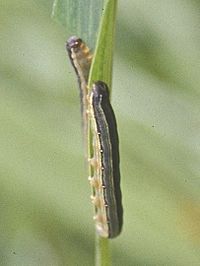
Photo from wikipedia
Abstract Spodoptera exigua (Hübner) is a polyphagous pest that shifts its population to different hosts during its life cycle to receive nutritive advantages. Therefore, demographic evaluation of alternate hosts is… Click to show full abstract
Abstract Spodoptera exigua (Hübner) is a polyphagous pest that shifts its population to different hosts during its life cycle to receive nutritive advantages. Therefore, demographic evaluation of alternate hosts is important for effective pest management. Here, we have evaluated castor (Ricinus communis L.), cauliflower (Brassica oleracea L.), cotton (Gossypium hirsutum L.), okra (Abelmoschus esculentus L.), and spinach (Spinacia oleracea L.) for growth, survival, and population development of S. exigua. Development of early populations of S. exigua is best supported on castor where earlier instars had least mortalities (10%) compared with spinach (36%), although later instars and pupae had significantly higher mortalities (20.8%) on it. Spinach and okra, on the other hand, promote larval survivals in later instars. Little or no differences in stadia lengths were observed during early development of larvae and, interestingly, the longevity of female moths increased significantly when reared on castor, cauliflower, and spinach (12.3, 11.3, and 11.7 d, respectively), resulting into significantly higher fecundity. The survival curves of all five populations have clearly demonstrated a steep early decline in larval numbers when reared on okra and only 60% larvae could survive. These findings conclude that S. exigua when fed on spinach was greatly disadvantaged in terms of growth and development; hence, the pest's field population can be opportunistically controlled by spraying adjacent spinach fields. In addition, the results highlight the vulnerable stages in pest's life cycle in the field where we can apply integrated control strategies for its effective management.
Journal Title: Environmental Entomology
Year Published: 2017
Link to full text (if available)
Share on Social Media: Sign Up to like & get
recommendations!